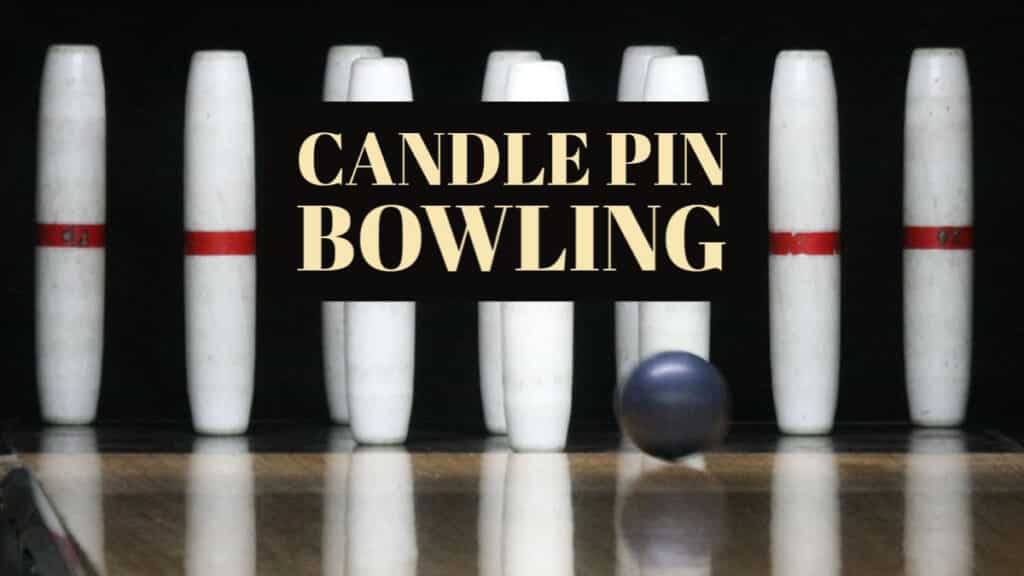If you are a bowling enthusiast, learning about different variations of the sport will be incredibly beneficial to your knowledge and would help you become better at the sport. One extremely popular variation of bowling is none other than Candlepin bowling. It is popular but at the same time not many people know about it.
You might be wondering, what is candlepin bowling and how to play it? Well, that is exactly what I am here to tell you.
In this article, I am going to talk about candlepin bowling, the history of the sport, how to play it, what the rules are, and everything in between. I am also going to talk about the popularity and professional records of the sport to let you know how well-loved it is across different regions. So, sit back, relax, and read this article till the end.

What is Candlepin Bowling?
Candlepin Bowling is a variation of simple bowling that is enjoyed mostly in the Canadian Maritime region of Nova Scotia, New Brunswick, and Prince Edward Island along with the New England region of the United States of America.
The game works like traditional bowling where you roll a candlepin bowling ball on the lane to knock down candlepins at the end of the bowling lane. The person with the most score wins at the end of the game.
Candlepin Bowling is a very niche variation of the sport since the most commonly played version is ten-pin bowling. It is a much more difficult and strategically different sport than ten-pin and that is why people where it originated from love the sport so much.
It is actually more similar to duckpin bowling in terms of rules than ten-pin bowling but when it comes to the name of the variation, it is known as candlepin bowling because of the long narrow pins that resemble candles used in this variation instead of duckpins and normal pins like in ten-pin bowling.
It is played both professionally and casually and you are going to see a lot of incredible bowling centers and entertainment zones in Canada and the United States offering Candlepin bowling alleys. People come to these regions from far and wide to play with their friends and family and even professionally to earn huge prizes in nationwide challenges and tournaments.
Candlepin Bowling History
When it comes to the history of Candlepin bowling, there are several records and pieces written about it and there is not much vagueness or complexity to the origin of this variation of the bowling sport.
According to most sources, the Candlepin Bowling variation originated in the Worcester region of the United States of America in a pool and billiards parlor and was invented by an individual named Justin White in the 1880s. Justin White spends a lot of time trying to get the dimensions and the size of the ball and the pins just right and finally succeeded.
The sport of Candlepin Bowling is older than duckpin bowling and spread through the Worcester region to all the rest of New England and even the Canadian Maritime region.
Over the course of history, candlepin bowling has not changed much and the dimensions of the bowling ball, the lane, and the pins have remained fairly similar to the early 1880s. From the 19th century up till the 21st century, candlepin bowling has been considered one of the most loved sports in these regions and is known across other regions as well.
Candlepin bowling is an extremely significant and rich variation of bowling and it requires a lot of skill and technique to perfect. That is why if you are thinking of learning about it, you are making the right decision.
Candlepin vs Ten-pin Bowling
Although ten-pin bowling and candlepin bowling belong to the same wider bowling sport, there are a lot of extremely significant differences between the variations in terms of rules, ways of playing, scoring mechanism, dimensions, equipment, and much more.
Let us take a look at all the differences between Candlepin and Ten-pin Bowling across all the factors of the game.
Bowling Ball
Candlepin Bowling balls are made of wood, plastic, rubber, or synthetic materials. We know that the bowling ball is meant to be rolled on the bowling lane to strike the pins at the end. That is one thing that is the same across the board in all the variations of bowling.
However, that is the one and the only similarity between candlepin and ten-pin bowling balls. Let us take a look at the differences between candlepin and ten-pin in terms of the ball used.
Dimensions of the Ball
If you look at the actual size of a traditional ten-pin bowling ball, you are going to see that it is around 8.5 inches in diameter and 10-16lbs in weight. Whereas candlepin bowling balls are smaller and much more lightweight with a weight of around 2.5 pounds and a diameter of 4.5 inches easily fitting in the hand of the bowler.
No Finger Holes
Unlike ten-pin bowling, the balls do not have three finger holes on the top to allow holding the ball. Instead, the ball is so small, even smaller than a duckpin bowling ball that it can easily be held in your hand due to its lightweight.
Throwing Style
One significant difference when it comes to candlepin vs. ten-pin bowling is the throwing style. In ten-pin bowling, you are supposed to curve and hook the ball and take advantage of the weight of the ball to knock the pins. However, in candlepin bowling, you are supposed to roll the ball directly towards the pins on the lane and make use of the deadwood and the pace of the ball.
Bowling Pins
Candlepin bowling pins are long and narrow. They are placed at the end of the 60ft bowling lane in an equilateral triangle shape to be knocked down for a single point individually. In comparison to bowling pins used in the ten-pin variation of bowling, candlepins are dimensionally completely different.
You might be wondering, how are they different?
Well, first of all, ten-pin bowling pins are slightly shorter than candlepins because the candlepins are about 15.75in height and by weight, they are similar to the weight of a candlepin bowling ball. They are much narrower too so, getting a strike with candlepins is much more difficult than ten-pins.
Bowling Lane
The bowling lane in candlepin also serves the same purpose as lanes in the ten-pin variation of the game. The purpose of the lane is to be used to slide the ball on in order to knock the pins placed at the end of it.
The candlepin bowling lane is also made of wood or synthetic material and then layered with oil to decrease friction between the ball and the surface, but there is a slight difference when it comes to the overall structure of the bowling lane when comparing ten-pin bowling and candlepin bowling. The dimensions of the bowling lane are the same across the board as well with 60ft from the foul line to the first pin, 15ft from the approach dots, and then 15ft to the aiming arrows from the foul line. There is nothing special about the dimensions.
The difference is in the size of the gutters. The candlepin bowling lane gutters are similarly sized in comparison to duckpin bowling gutters than ten-pin gutters because of the smaller size of the balls used in both duckpin and candlepin bowling.
Read more here: What is a Gutter Ball in Bowling?
How to Play the Game?
Now that you know about all the equipment and the bowling lanes of candlepin bowling, you must be curious about how exactly the game, the rules, and the scoring mechanism work. Well, do not worry because I am going to explain everything there is about the way to play candlepin bowling perfectly.
Rules for Candlepin Bowling
The purpose of candlepin bowling is for the bowler to throw the bowling ball towards the candlepins to knock as many as they can in the set of 10 whole frames.
There are 10 frames in a game and each frame is considered one turn. In each frame, the player is allowed three shots. This is because the game is harder than ten-pin bowling. If the player moves over the foul line, the turn will not be counted, and the score will be marked 0. If the ball comes out of the gutter and hits a standing pin, it will also be considered a foul.
Unlike ten-pin and duckpin bowling, the deadwood or fallen pins cannot be removed within the frame. This adds a layer of complexity and strategy to the game since players can use the fallen pins to deflect and knock the other standing pins. These are the basic rules of the game which you are going to need to know about in order to play a good game.
Scoring Mechanism
When it comes to the scoring mechanism, there is not much difference in comparison to duckpin or ten-pin bowling. But if you are not familiar with bowling scores, do not worry, I have got you covered.
Strike
If you are able to knock all the ten candlepins in the first shot, you’ll get a strike and the score in that frame will be equal to 10 plus the score in your next two shots. If you are able to strike three times in a row, you’ll get 30 in a single frame.
The maximum achievable score in candlepin bowling is 300 after 12 consecutive strikes but no one has achieved this score yet due to the sheer difficulty of the sport.
Spare
If you are not able to knock all the pins in the first shot but you knock the remaining pins in the second shot, then you are going to achieve a spare and the score of that particular frame will be 10 plus the score of the next shot you take.
For example, if you score a spare and then score a strike in the next shot, the score in the particular frame will be 20. This is also something very proficient and professional players can do.
Open Frame
Failure to completely knock all the pins in the first two shots or all three shots will result in you receiving a single point for each individual candlepin you were able to knock down in that frame.
Another case of an open frame is where you are not able to score any point at all and all of your shots went into the gutters. In such a case, your total score in the frame will be 0.
Read an in-depth article on the topic here: What is a Frame in Bowling?
Candlepin World Records
Candlepin bowling is an incredibly difficult sport, and that is exactly why a lot of people have tried to etch their names in the history books by making world records in it. Let us take a look at how skilled the professionals are in the field of Candlepin bowling.
Highest Candlepin Bowling Score
In 1984, an individual professional player is known as Ralph Semb from Erving, MA created the record of the highest candlepin score in one game which is set by him at 245. This is incredibly exceptional seeing that scoring such a high is unbelievably difficult in sanctioned games.
Highest 3-game set mark
Mark Ricci in 2011, from Somerville, MA broke the highest 3-game set mark record by tallying scores of 160, 157, and 202 in 3 consecutive games totally scoring 519 which was 5 more than the previous record. This is an exceptional feat in the field of candlepin bowling.
Conclusion
Candlepin bowling is truly an amazing sport if you are willing to give it a try. There is far more strategy and understanding required in order to win in this game as compared to other variations of the bowling sport.
With this guide, I hope you learned a lot about the history and the rules of candlepin bowling because this knowledge will help you become proficient in the sport.
So, do not hesitate in giving it a chance. You are going to learn things quickly and become better at it very soon. I hope that you have an incredible candlepin bowling experience both for fun and professionally if you would like to pursue that route.




